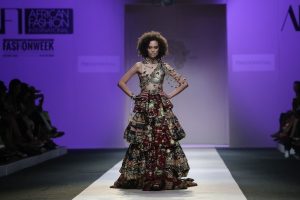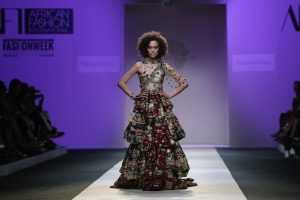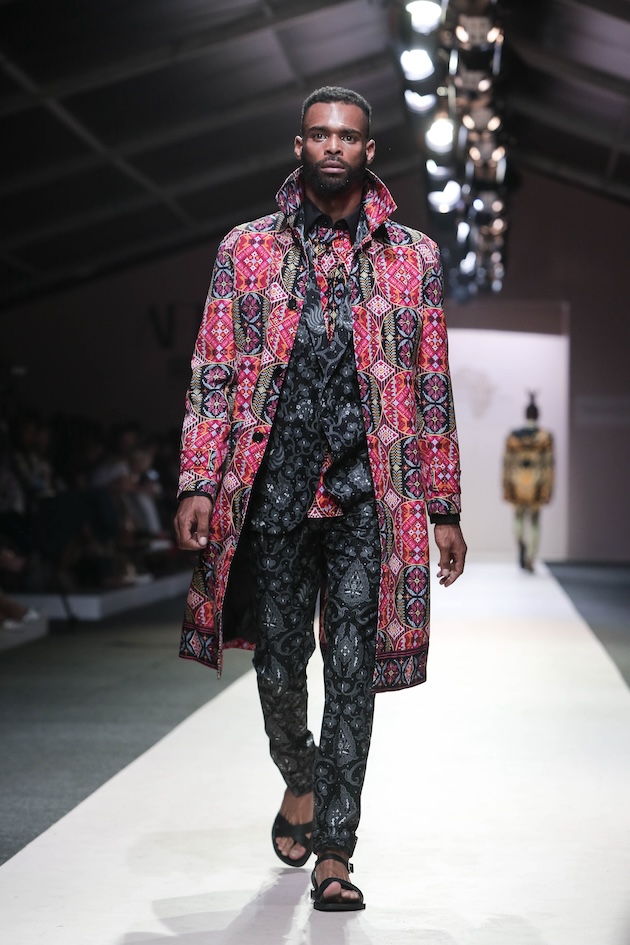Made in Africa: Africa’s Fashion Redefining Narratives About the Continent
 1 April 2024
1 April 2024

A model wearing a dress from the Presidential collection created by Theresa Giannuzzi, as part of South African Fashion Week. The collection was inspired by the clothes worn by former South African President Nelson Mandela.
By Joyce Chimbi
NAIROBI, Apr 1 2024 (IPS)
It is a new dawn as Africa’s high fashion industry enters an era defined and driven by young African fashion designers. As they take to the global stage, the young creatives are showcasing the continent in all its majesty through unique weaving techniques and patterns that combine their rich African heritage with contemporary styles.
The African continent has what it takes to become one of the next-generation fashion leaders. Africa is a major producer of raw materials—37 out of 54 countries produce cotton, an exporter of textiles to the value of USD 15.5 billion a year, and an importer of textiles, clothing, and footwear to the value of USD 23.1 billion a year, according to the United Nations Educational, Scientific, and Cultural Organization (UNESCO).
“When it comes to fashion, I buy Kenya to build Kenya. We have no shortage of high-quality, fabulous designs. We have done very well with the Maasai Shuka—a thick, hard cotton blanket wrap. Taking to the world a piece of clothing that was traditionally worn by the Maasai—one of our ethnic groups known for remaining true to their culture,” says Sheila Shiku, a Nairobi-based fashionista.
Buy Kenya, Build Kenya is a six-year-old government strategy to unlock the potential of the local market. Kenya is in good company, as some of Africa’s most notable cities as nexuses for fashion and design as well as hubs for finance and commerce are Nairobi, Lagos, Casablanca, and Abidjan.
UNESCO’s first-ever report on the African fashion industry launched last year laid bare the trends, successes, and challenges facing the promising sector while also detailing how the continent’s fashion sector is proving to be a powerful engine for the made-in-Africa movement, placing Africa on the world fashion map.
African fashion is booming. Fashion weeks galvanize markets and creators in 32 countries across the continent, from Casablanca to Nairobi, via Lagos and Dakar. The growth in e-commerce, which attracted 28 percent of Africans in 2021 compared to 13 percent in 2017, has led to an increase in local consumers, per the report titled The Fashion Sector in Africa: Trends, Challenges, and Opportunities for Growth.

A model wearing a suite from the Presidential collection created by Theresa Giannuzzi as part of SA Fashion Week. Nelson Mandela, a former president of South Africa, served as the inspiration for the collection.
Stressing how the fashion sector has created new opportunities for the international development of African brands, whose annual textile, clothing, and footwear exports amount to USD 15.5 billion. For Africa, fashion is a powerful driver of creativity, economic development, and innovation, creating many jobs, especially for women and young people.
UNESCO is keen to ensure that the recommendations made in the report are implemented with a view to supporting, boosting, and accelerating the growth of Africa’s fashion sector. Providing the first-ever overview of the fashion industry at the continental level, the report also outlines prospects for the industry’s future.
Made-in-Africa is gaining traction, particularly among young people under 25 years old, such as Shiku, who account for 50 percent of the continent’s total population, and among the burgeoning middle class, which already makes up more than 35 percent of the population, opening up new consumer markets.
“They say that we are not Africa’s because we were born in Africa but because Africa was born in us. Young people communicate through their choice of clothes and music. The only challenge we have is that fashionable high-end clothing is a little bit more expensive than mitumba (second-hand clothing imported into Kenya from the U.S. and Europe),” Shiku observes.
Africa is also experiencing very rapid growth in the digital sector, facilitating intra-African trade and the emergence of young talent. As evidenced by the 32 Fashion Weeks held each year, Africa is also brimming with talent in the fields of haute couture, crafts, and clothing. A 42 percent increase in demand for African haute couture is expected over the next 10 years.
Equally important, the report underlines the economic and social opportunities created by the sector, 90 percent of which is composed of small and medium-sized enterprises, whose profits directly benefit populations. The fashion sector could be a powerful springboard for gender equality, at a time when only 17 percent of the 3.5 million cotton farmers in African least-developed countries are women.
UNESCO organized an event that brought together various designers and strategic partners in the fashion sector to explore possible opportunities and synergies for the development of the vibrant industry in Africa. But to also find solutions to some of the most pressing challenges facing the fashion industry,.
These challenges include insufficient investment and infrastructure, incomplete intellectual property legislation, and elevated fabric sourcing costs. Moreover, in Africa and elsewhere, the sector’s environmental impact—one of the biggest sources of pollution worldwide—must be taken into account.
To build a robust and virtuous fashion ecosystem, the report says governments and decision-makers need reliable data and contributions from experts and civil society, underscoring the need for public policies and practices that protect and support creators.
At the same time, it highlights the urgent need to foster the development of fashion that is both more sustainable and more equitable, not to mention respectful of local skills and knowledge. For this sector to remain a driver of innovation and creativity, it must also reflect cultural diversity, including its rich textile traditions.
IPS UN Bureau Report
IPS: UN Bureau, IPS UN Bureau Report, Kenya, UNESCO
